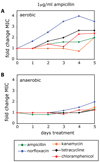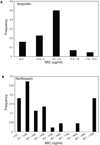Sublethal antibiotic treatment leads to multidrug resistance via radical-induced mutagenesis
- PMID: 20159551
- PMCID: PMC2840266
- DOI: 10.1016/j.molcel.2010.01.003
Sublethal antibiotic treatment leads to multidrug resistance via radical-induced mutagenesis
Abstract
Antibiotic resistance arises through mechanisms such as selection of naturally occurring resistant mutants and horizontal gene transfer. Recently, oxidative stress has been implicated as one of the mechanisms whereby bactericidal antibiotics kill bacteria. Here, we show that sublethal levels of bactericidal antibiotics induce mutagenesis, resulting in heterogeneous increases in the minimum inhibitory concentration for a range of antibiotics, irrespective of the drug target. This increase in mutagenesis correlates with an increase in ROS and is prevented by the ROS scavenger thiourea and by anaerobic conditions, indicating that sublethal concentrations of antibiotics induce mutagenesis by stimulating the production of ROS. We demonstrate that these effects can lead to mutant strains that are sensitive to the applied antibiotic but resistant to other antibiotics. This work establishes a radical-based molecular mechanism whereby sublethal levels of antibiotics can lead to multidrug resistance, which has important implications for the widespread use and misuse of antibiotics.
Figures




Comment in
-
The fast track to multidrug resistance.Mol Cell. 2010 Feb 12;37(3):297-8. doi: 10.1016/j.molcel.2010.01.027. Mol Cell. 2010. PMID: 20159549
-
Reactive resistance.Nat Rev Genet. 2010 Apr;11(4):240. doi: 10.1038/nrg2769. Nat Rev Genet. 2010. PMID: 21488228 No abstract available.
Similar articles
-
The fast track to multidrug resistance.Mol Cell. 2010 Feb 12;37(3):297-8. doi: 10.1016/j.molcel.2010.01.027. Mol Cell. 2010. PMID: 20159549
-
Antidepressant fluoxetine induces multiple antibiotics resistance in Escherichia coli via ROS-mediated mutagenesis.Environ Int. 2018 Nov;120:421-430. doi: 10.1016/j.envint.2018.07.046. Epub 2018 Aug 18. Environ Int. 2018. PMID: 30125859
-
Combined exposure to non-antibiotic pharmaceutics and antibiotics in the gut synergistically promote the development of multi-drug-resistance in Escherichia coli.Gut Microbes. 2022 Jan-Dec;14(1):2018901. doi: 10.1080/19490976.2021.2018901. Gut Microbes. 2022. PMID: 35014598 Free PMC article.
-
Killing by bactericidal antibiotics does not depend on reactive oxygen species.Science. 2013 Mar 8;339(6124):1213-6. doi: 10.1126/science.1232688. Science. 2013. PMID: 23471410
-
Combination of bactericidal antibiotics and inhibitors of Universal stress protein A (UspA): a potential therapeutic alternative against multidrug resistant Escherichia coli in urinary tract infections.J Antibiot (Tokyo). 2022 Jan;75(1):21-28. doi: 10.1038/s41429-021-00477-4. Epub 2021 Sep 15. J Antibiot (Tokyo). 2022. PMID: 34526667
Cited by
-
Oral Antibiotics for Acne.Am J Clin Dermatol. 2021 Mar;22(2):193-204. doi: 10.1007/s40257-020-00560-w. Am J Clin Dermatol. 2021. PMID: 32918267 Review.
-
Clinicopathological Profile in Patients with Tubercular Cervical Lymphadenitis and Its Treatment Outcome.Indian J Otolaryngol Head Neck Surg. 2024 Oct;76(5):4080-4085. doi: 10.1007/s12070-024-04786-6. Epub 2024 Jun 14. Indian J Otolaryngol Head Neck Surg. 2024. PMID: 39376317
-
Antimicrobial Peptides can Enhance the Risk of Persistent Infections.Front Immunol. 2012 Aug 1;3:222. doi: 10.3389/fimmu.2012.00222. eCollection 2012. Front Immunol. 2012. PMID: 22870073 Free PMC article. No abstract available.
-
Sublethal ciprofloxacin treatment leads to rapid development of high-level ciprofloxacin resistance during long-term experimental evolution of Pseudomonas aeruginosa.Antimicrob Agents Chemother. 2013 Sep;57(9):4215-21. doi: 10.1128/AAC.00493-13. Epub 2013 Jun 17. Antimicrob Agents Chemother. 2013. PMID: 23774442 Free PMC article.
-
Rapid induction of high-level carbapenem resistance in heteroresistant KPC-producing Klebsiella pneumoniae.Antimicrob Agents Chemother. 2015;59(6):3281-9. doi: 10.1128/AAC.05100-14. Epub 2015 Mar 23. Antimicrob Agents Chemother. 2015. PMID: 25801565 Free PMC article.
References
-
- Andersson DI. Persistence of antibiotic resistant bacteria. Curr Opin Microbiol. 2003;6:452–456. - PubMed
-
- Beaber JW, Hochhut B, Waldor MK. SOS response promotes horizontal dissemination of antibiotic resistance genes. Nature. 2004;427:72–74. - PubMed
-
- Becnel Boyd L, Maynard MJ, Morgan-Linnell SK, Horton LB, Sucgang R, Hamill RJ, Jimenez JR, Versalovic J, Steffen D, Zechiedrich L. Relationships among ciprofloxacin, gatifloxacin, levofloxacin, and norfloxacin MICs for fluoroquinolone-resistant Escherichia coli clinical isolates. Antimicrob Agents Chemother. 2009;53:229–234. - PMC - PubMed
Publication types
MeSH terms
Substances
Grants and funding
LinkOut - more resources
Full Text Sources
Other Literature Sources
Medical
Molecular Biology Databases

